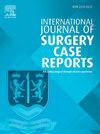髌骨近端肌腱损伤伴骨膜套撕脱1例及长期随访。
IF 0.6
Q4 SURGERY
引用次数: 0
摘要
儿童急性髌骨肌腱损伤是罕见的,但由于更多的高能运动的参与增加。这些损伤通常包括骨骨折,孤立的肌腱撕脱不常见。及时诊断和手术干预对于恢复膝关节功能和损伤前活动水平至关重要。病例介绍:一名12岁的男学生运动员在踢足球时右膝屈曲,被送往医院。他表现出明显的压痛、肿胀和无法主动伸展膝盖。临床发现髌骨下极下方有明显间隙。讨论:最初的x线影像不确定。MRI证实髌骨下段近端跟腱撕脱,远端跟腱上附狭窄的软组织套筒。无骨撕脱或发现。有趣的是,术中,覆盖髌骨的骨膜套完全撕脱。经骨缝合修复与缝合锚增强。然后将骨膜套完全复位。术后3年,患者成为一名职业篮球运动员,膝关节活动完全,无疼痛或不稳定,在高强度活动中表现出色,没有任何限制。结论:无骨撕脱的孤立性髌骨近端肌腱损伤是罕见的,并伴有完全骨膜套脱离更是罕见。经骨修复和缝合锚定增强相结合确保了长期的稳定性。这种方法有效地分散了拉伸力,最大限度地降低了再次损伤和修复失败的风险。量身定制的康复治疗确保了膝盖的完全恢复,长期的随访证实了他可以毫无限制地重返职业运动。本文章由计算机程序翻译,如有差异,请以英文原文为准。
Proximal patellar tendon injury with avulsed periosteal sleeve: A case report and long-term follow-up
Introduction
Acute patellar tendon injuries in children are rare but increasing due to more high-energy sports participation. These injuries often involve bony fractures, with isolated tendon avulsions being uncommon. Timely diagnosis and surgical intervention are essential to restore knee function and pre-injury activity levels.
Case presentation
A 12-year-old male student-athlete was brought to the hospital after his right knee buckled while playing football. He exhibited significant tenderness, swelling, and an inability to actively extend the knee. Clinically, a palpable gap below the inferior pole of the patella was detected.
Discussion
Initial X-ray imaging was inconclusive. MRI confirmed a proximal patellar tendon avulsion from the inferior patella, with a narrow soft tissue sleeve attached to the distally retracted tendon. No bony avulsion or was found. Interestingly, intraoperatively, there was a complete avulsion of the periosteal sleeve covering the patella. Transosseous suture repair with suture anchor augmentation was performed. Followed by full reattachment of the periosteal sleeve. Three years post-surgery, the patient became a professional basketball player with full knee motion, no pain or instability, and excelled in high-intensity activities without limitations.
Conclusion
Isolated proximal patellar tendon injury without bony avulsion is rare, and its association with complete periosteal sleeve detachment is exceptionally uncommon. The combination of transosseous repair and suture anchor augmentation ensured long-term stability. This approach effectively distributed tensile forces, minimizing the risk of re-injury and repair failure. A tailored rehabilitation ensured full knee recovery, with long-term follow-up confirming a return to professional sports without limitations.
求助全文
通过发布文献求助,成功后即可免费获取论文全文。
去求助
来源期刊
CiteScore
1.10
自引率
0.00%
发文量
1116
审稿时长
46 days

 求助内容:
求助内容: 应助结果提醒方式:
应助结果提醒方式:


